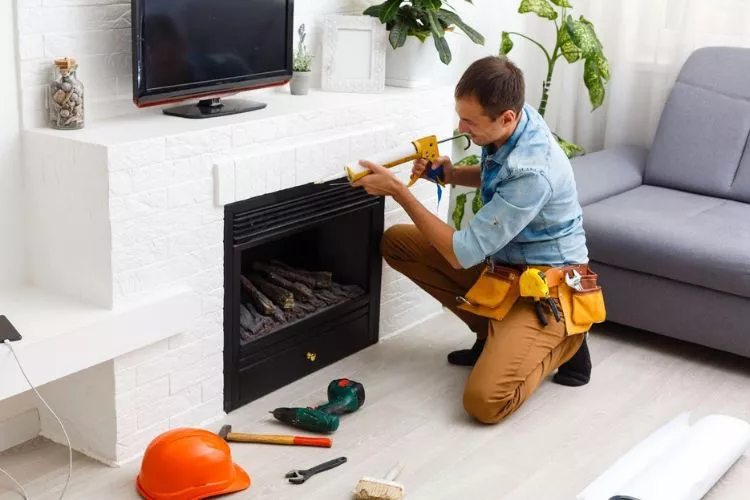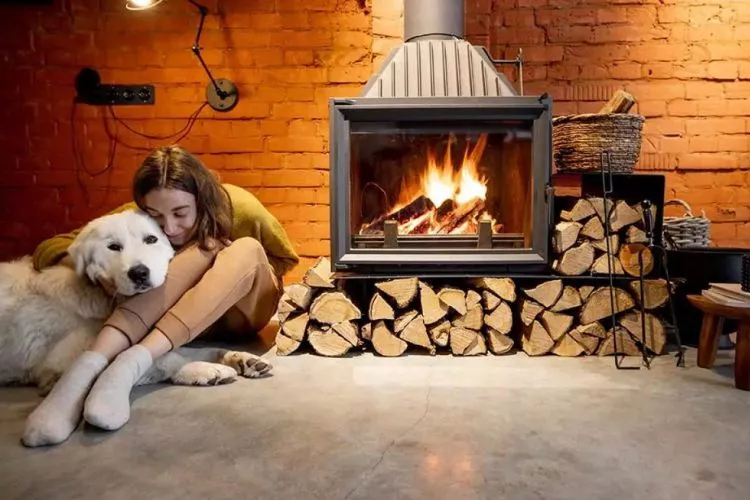Fireplaces bring warmth and style to homes. But, can you move a fireplace?
It’s an interesting query to have, because there can be many benefits if you actually can do that.
In this article, we explore the possibility of relocating these cozy heat sources. Discover the steps, challenges, and options available to make your dream layout a reality.

Can you move a fireplace?
Yes, you can move a fireplace. It’s a task that involves careful planning and skill. Various factors come into play. These include the type of fireplace (wood, gas, or electric), its size, and its current installation.
Usually, a professional contractor is needed. Their expertise ensures the job is done safely. Wood and gas fireplaces are trickier due to their venting systems.
Electric fireplaces are easier to move. Still, you need to think about the new location’s suitability, safety, and venting needs.
It’s not easy. It comes with cost and potential home disruption. But, if planned and done right, it is possible to move your fireplace.
Can you move a fireplace without moving the chimney?
Moving a fireplace without moving the chimney is tough. Fireplaces and chimneys are interconnected.
You may reposition a fireplace within a certain range using the same chimney. But complete relocation? It’s mostly unfeasible. Ensuring proper ventilation becomes a key challenge.

Yet, an electric fireplace or a vent-free gas model can be an exception. These don’t need chimneys, giving more freedom to relocate.
Remember, safety remains paramount whether it’s a minor shift or a full-on move. The help of a professional during such relocations is a wise choice.
How do you move a wood fireplace?
Warning: This guide is meant for informational purposes only. Since moving a wood fireplace involves complex tasks, professional help is advised. Incorrect handling of a fireplace can lead to safety hazards.

Step 1: Be Aware of the Task at Hand
Understand that moving a wood fireplace is a multifaceted and potentially hazardous task. The entire process will require careful planning and execution, starting with the dismantlement of the fireplace, preparing the new site for installation, and eventually the reinstallation.
The fireplace unit’s weight can lead to physical injuries if not handled properly. Moreover, a fireplace has to be reinstalled correctly with proper ventilation to prevent safety hazards such as carbon monoxide leakage or fire breakouts.
Moving the fireplace could also necessitate certain construction changes at the new location. Depending on the fireplace and the new chosen spot, such modifications could range from creating an opening in the wall to setting up a new chimney or ventilation system.
Remember, ensuring all safety measures are followed is of paramount importance during this process. Mistakes can lead to serious problems, including potential fire hazards.
Step 2: Choose The New Location
Find a suitable spot for the fireplace. Keep flammable materials and objects at a safe distance. Take into account the space needed for ventilation, like a chimney or flue.
Step 3: Obtain Necessary Permits
Check with your local government for any permits related to moving a wood fireplace. Some areas may have specific rules or codes to follow. Make sure to abide by those requirements.
Step 4: Gather Needed Tools
You’ll need a variety of tools to move the fireplace. These include a pry bar, protective gloves, a screwdriver, a level, and a power drill, among others.
Step 5: Dismantle The Fireplace
Turn off the gas or electricity source, if applicable. Remove any decorative features and accessories.
Detach the wood burning insert from the chimney. Finally, remove any securing hardware to free the insert from its original position.
Step 6: Prepare The New Location
Ensure that the new site is ready for installation. You might need to create an opening in the wall, or set up a chimney or venting system. Make sure the area is clean and free from debris.
Step 7: Install The Fireplace
Secure the wood burning insert at the new location. Make sure it’s positioned and leveled correctly. Connect the new venting system, following safety guidelines and regulations.
Step 8: Test The Fireplace
Verify that your fireplace is functioning as it should. Light it with real wood or use a fire starter to check the burning process. Monitor the air quality, and ensure that the venting system is functioning correctly.
Step 9: Cleanup
Clear away any tools and debris from the new fireplace location. Dispose of any waste in a safe and responsible manner.
Even with this DIY guide, moving a wood fireplace can be complex and hazardous work. To ensure absolute safety and proper installation, consider having a professional contractor perform the move.
Certainly! Here are revised versions for Step 1 of both guides:
How to move a gas fireplace?
Warning: This guide is meant for informational purposes only. Since moving a gas fireplace involves complex tasks, professional help is advised.

Incorrect handling of a gas fireplace can lead to safety hazards. Be aware of the risks involved with handling gas lines.
Step 1: Acknowledge the Nature of the Task
Shifting a gas fireplace involves several intricate steps and handling volatile components, specifically gas lines. It’s vital to comprehend that the entire process, from disconnecting the gas line safely to reinstalling and testing the fireplace at the new location, needs careful planning and execution.
Besides potential injuries due to the heavy weight of the fireplace, improperly handling gas lines can lead to gas leaks. This can further lead to hazardous situations, such as fire or even explosions.
Furthermore, modifications may be needed at the targeted spot to accommodate the gas fireplace. This can include tasks like drilling for new gas lines or establishing a suitable ventilation system.
Following each safety measure during the relocation process is highly crucial—be it while handling the gas lines, ensuring proper installation, or checking for gas leakages after installation.
Step 2: Choose The New Location
Find a suitable spot for the fireplace, keeping flammable materials and objects away. Take into account all necessary space for proper ventilation, like a flue, whenever required.
Step 3: Obtain Necessary Permits
Check with your local government for any permits related to moving a gas fireplace. Some areas may have specific rules or codes to follow. Make sure to abide by those requirements.
Step 4: Gather Needed Tools
You’ll need a variety of tools such as an adjustable wrench, pipe wrench, pipe cutter, pipe threader, Teflon tape, safety gloves and glasses, and a gas leak detector, among others.
Step 5: Disconnect The Gas Line
Turn off the main gas source and make sure the fireplace is cool. Disconnect the gas line from the fireplace carefully. Double-check for any residual gas. Consult a professional if you’re unsure.
Step 6: Dismantle The Fireplace
Take off any decorative elements and accessories. Detach the gas burning insert from the chimney or vent if present. Remove all securing hardware to free the insert from its original position.
Step 7: Prepare The New Location
Ensure that the new site is ready for installation. You might need to create an opening in the wall or set up a new venting system. Make sure the area is clean and free from debris.
Step 8: Set Up The Gas Line
Run a gas line to the new location, ensuring it complies with local regulations. It’s highly recommended that you consult a professional for this task. They can ensure the gas line is installed safely and properly.
Step 9: Install The Fireplace
Secure the gas burning insert at the new location. Position it and level it correctly. Connect the new venting system, following safety guidelines and regulations. Reconnect the gas line to the fireplace.
Step 10: Test The Fireplace
Thoroughly check for any gas leaks using a detector. Test the proper functioning of the fireplace, air quality, and ensure that the venting system is functioning correctly.
Step 11: Cleanup
Clear away any tools and debris from the new fireplace location. Dispose of any waste in a safe and responsible manner.
Even with this DIY guide, moving a gas fireplace can be complex and hazardous work. To ensure absolute safety and proper installation, consider having a professional contractor carry out the move.
Is it expensive to move a fireplace?
The cost to move a fireplace around can vary greatly, but typically it falls between $500 and $2,500. Moving a gas fireplace often costs $500 to $1,000 due to the rerouting of gas lines.

Moving a wood-burning fireplace might be more expensive because it requires constructing a new chimney or ventilation system. That might range from $500 to $1,500.
Hiring a professional who has experience with fire safety equipment is usually necessary which leads to labor costs from $100 to $500. Please note that these are estimates and actual costs can vary based on the specifics of each individual case.
Conclusion:
Moving a fireplace, whether it’s gas or wood-burning, is indeed possible but involves careful planning and execution. It requires managing potential risks, ensuring thorough safety measures, and bearing substantial costs.
While it presents an opportunity to redesign your interior space, it’s essential to weigh these considerations beforehand. Therefore, always consult a professional to guide you through the process, ensuring a smooth and safe fireplace relocation.


